Authors: Ovsyaniker D.Y., Strunkin G.N., Shmarovoz S.V., Stanishevskiy D.S., Mikhnevych М.I.
Journal (bulletin) of the International Association "METRO""МETRO INFO International". – 2019. - №1. – P. 14-19
Innovative solution for DC current switching — AFB arc-free ultra high-speed DC circuit breaker
Key words: ultra high-speed circuit breaker, AFB, arc-free, opening time, power circuit interruption in vacuum.
As a rule, DC switching in electric transport traction networks is connected with severe modes for traction networks and switching units. Immediate interruptions in traction network with rated currents and currents higher than rated, much less protective interruptions of emergency currents — complicated processes, that as a consequence of thermal and electrodynamic (upon short circuits) impact on networks and switchgears can lead to both traction network defects and switchgear failure. As a rule, emergency currents interruption comes with arcing and plasma generation with release of the bulk of energy and gases. Technology of immediate interruptions and interruption of emergency currents, occurred in traction networks, comes up against conflicting requirements. For example, it is logical to assume that the faster switchgear will open emergency circuit, the less damages will occur in this network (e.g. contact wire burning-off, destruction of supporting insulation, fire outbreak, diodes breakdown in rectifier, welding up of contact in switchgear etc.). However, too quick emergency currents interruption provides high level of overloads in contact network. Therefore, high-speed interruption is good, but not without negative influence on for cables electrical insulation of switchgears connected to the network.
Developers of DC switching units face some difficulties upon low currents interruption. Because of low level of magnetic arc blow, occurred upon low currents interruption, arcing time and possibility of contact welding up increase. In this mode, contact wire is subject to long-term thermal influence. This leads to contact wire sag and burning-off.
.png)
.png)
Main contacts wear is a key factor that reduces lifetime of switchgears. Developers rely on various design and technological manoeuvres in order to prolong a lifetime of main contact (they use auxiliary arc interruption contacts, experiment with silver and other metals alloys, enlarge area of contact connection in movable and fixed contact pair, make arc interrupter more complicated and expensive for more effective arc interruption and for minimizing impact of arc on main contact).
Complexity of DC switching in comparison with AC switching is that upon AC interruption current in occurring electric arc passes through “zero”, and thereby simplifies arc interruption at the level of physical processes. Upon DC switching current in electric arc does not pass through “zero”, and physical processes do not help to interrupt current, and thus, to interrupt arc. Arc interrupter simplifies arc interruption by breaking a large arc into a number of little arcs that can be interrupted easier.
Certainly, developers of switchgears succeeded in switching. Values of interrupted currents and dynamic characteristics of circuit breakers significantly increased, tripping time upon relatively small overloads that arise during switching, reduced. Achieved high-speed operation of DC circuit breakers — total tripping time in the range of 20–50 ms, and interrupted currents — up to 180 kA.
However, DC circuit breakers did not reach high level of reliability, safety, environmental friendliness and economic efficiency of operation that is typical of AC vacuum circuit breakers. The key thing was nor reached: upon DC circuit breakers operation operation personnel is not confident about that fact that circuit breaker will not fail because of main contact failure during further switching process. Further, it is unclear, if main contact state after series of switchings (series from only a few switchings up to several dozens of switchings) allows further circuit breaker operation. Arc interrupter also needs periodic inspection and maintenance, in order to avoid emergency tripping. Regulations of inspections, periodic maintenance and repair of circuit breakers still happen, and this fact points to unsatisfying reliability, as well as makes operation process of DC circuit breakers within their lifetime more expensive. Environmental safety during operation of high-speed DC circuit breakers is also far from perfect. In fact, DC switching technology did not change since 50th and has all disadvantages and particularities described above.
Meanwhile all challenging issues regarding AC switching technology have been already solved. Switching is carried out in vacuum (or in inert gase), personnel does not examine contacts, and there is no plasma in switchgears and no gas emission. There is no arc interruption contacts and no contacts maintenance.
PLUTON engineers decided to cross swords with physical laws and eliminate unfairness that seemed to be eternal accompanee of high-speed DC circuit breakers. We developed AFB ultra-high-speed DC circuit breaker — arc-free circuit breaker with DC switching in vacuum interrupter, free from disadvantages of DC circuit breakers with standard switching, and in contrast, has advantages of vacuum circuit breakers (pic. 2).
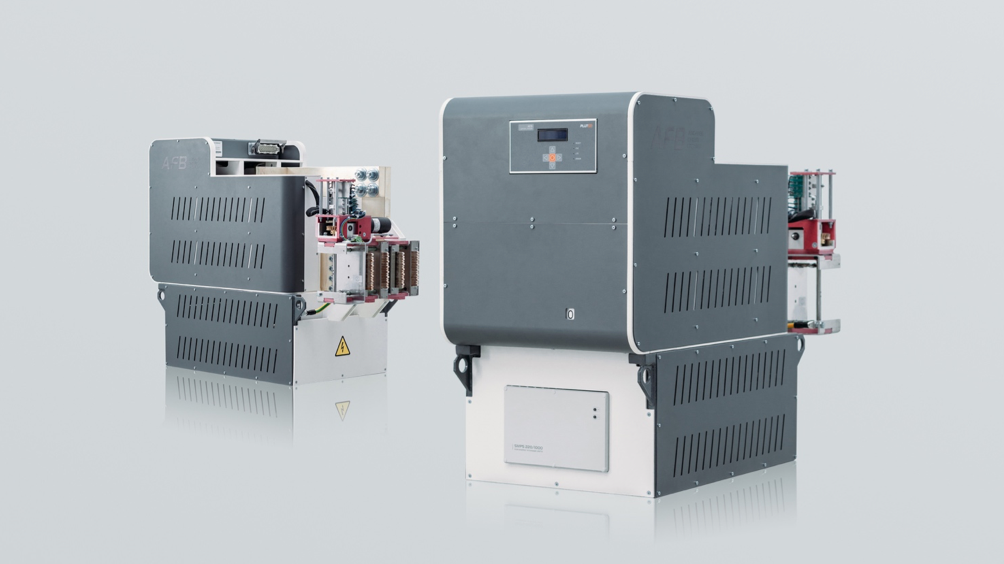
Initially, our engineers faced a task to develop circuit breaker with maximum high-speed operation (short opening time is < 1 ms) with minimum level of overloads ejected into contact network (max. 2 kV for circuit breaker with rated current of 2500 А), ultra reliable circuit breaker with no need for periodic maintenance and repairs, with long lifetime (minimum 25 years), with no harmful impact on the environment.
High-speed operation. Circuit breakers are considered to be high-speed, if their own tripping time doesn’t exceed 5 ms. Total tripping time differs from own tripping time by additional arcing time, i.е. total tripping time (or tripping time) consists of the sum of own tripping time and arcing time. It is obvious, that the less tripping time value, the lower amplitude and steady state short circuit current value arises in emergency circuit by the same current rate of rise (di/dt).
Circuit breaker with traditional switching upon own opening time of 4,3 ms (under di/dt = 3 х 106 А/s) provides total opening time depending on network parameters in the range of 20-50 ms. Herewith short circuit currents amplitude reaches values from 10 up to 100 kА and more depending on the network parameters. Certainly, the case is about average values. Opening time of the AFB high speed circuit breaker is less than 1 ms, and total opening time is less than 4 ms. Therefore, upon calculated value of short circuit current in the network of 100 kA, in practice current has time to reach 4–25 kA. Such a high-speed operation is achieved by the fact that AFB circuit breaker, with operation of main contact in vacuum, has no arc generation process, and contacts mechanically open during less than 1 ms. Thereby, due to a lack of arc, current interruption is carried out through the main contact almost in the same time. Therefore, AFB circuit breaker provides high-speed power contacts opening and high-speed fault current interruption. Besides, AFB circuit breaker is able to detect emergency process by current rate of rise (di/dt) and carries out emergency network tripping before current reaches Imax protection setting. Circuit breaker is equipped with special circuits, designed for reducing level of overloads that unavoidably arise upon such high-speed trippings. Due to these unique high-speed operation characteristics, we specify AFB circuit breaker as ultra high-speed circuit breaker.
Taking into account that fact that AFB circuit breaker is bidirectional, main contact tripps circuit in vacuum upon no arc, opening time does not depend on current rate of rise (di/dt) — there are no difficulties with low current interruption.
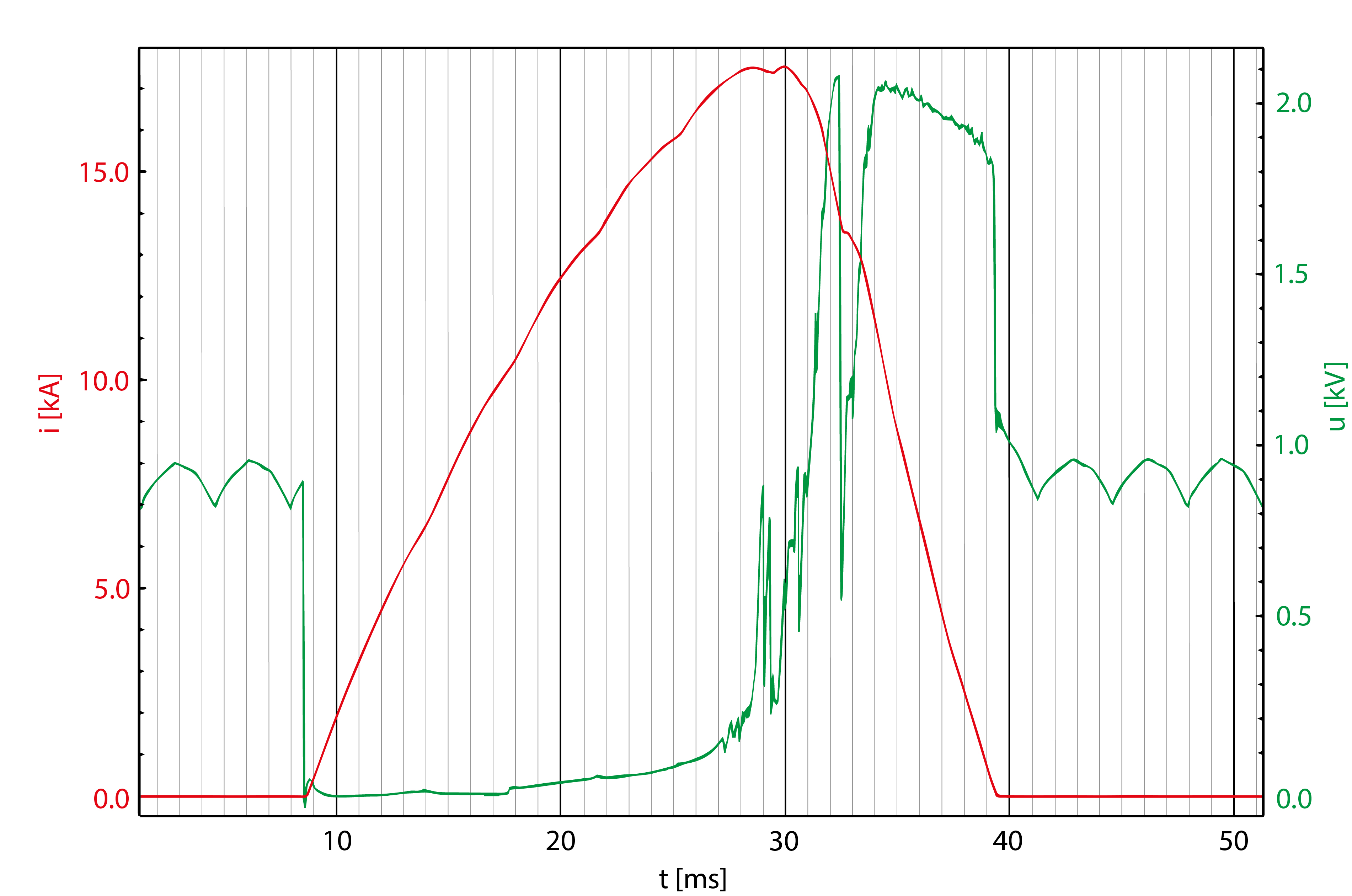
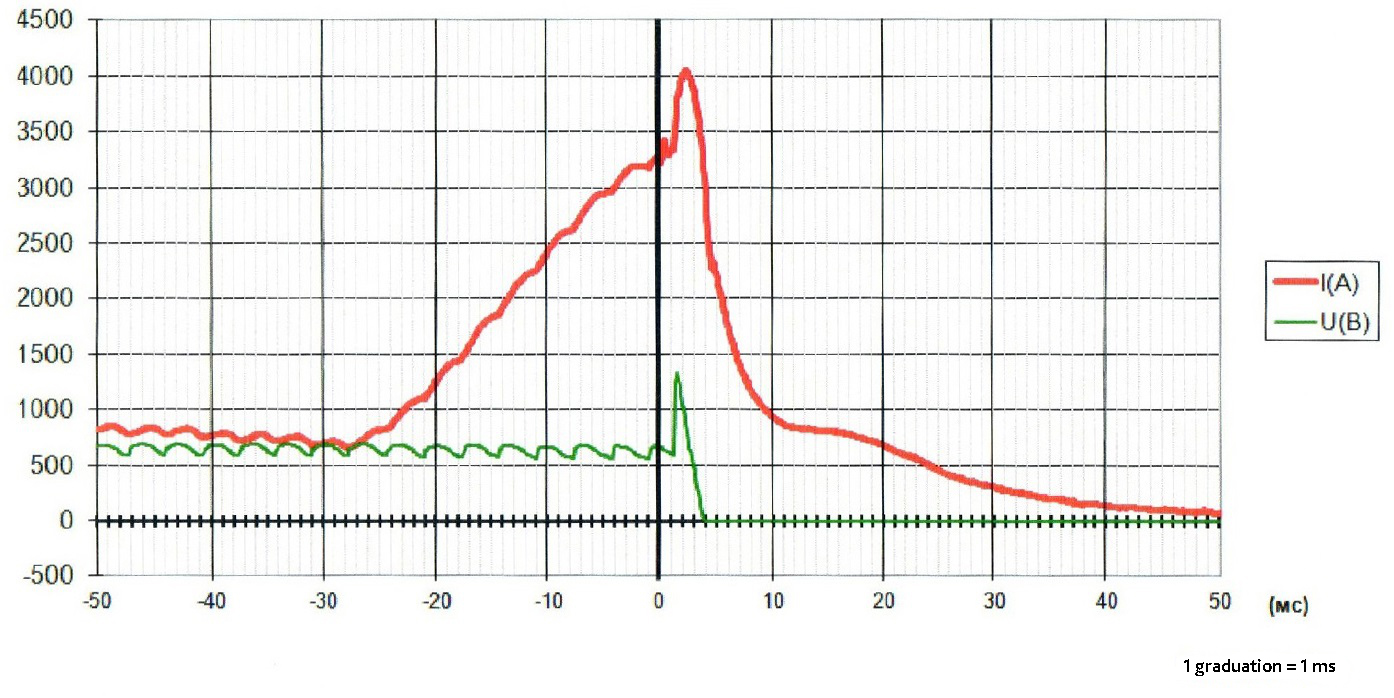
Innovations and advantages:
- main innovation of AFB circuit breaker isoperation of main contact in vacuum. For short circuit current interruption current is switched in antiphase to the main current of power circuit from pre-charged high-voltage capacitor, and as a result, these currents are mutually subtracted. Therefore, main contact opening process is carried out with current value that is close to zero, thereby there is no arc upon interruption of currents regardless of their values;
- built-in line test system for detection of permanent short circuit;
- circuit breaker opening time does not depend on current rate of rise (di/dt);
- AFB circuit breaker has no arc interruption contacts, and as a result, there is no need for their periodic replacement;
- main contact is located in vacuum interrupter and does not wear out, consequently there is no need of contact inspection, maintenance and replacement up to the expiry of vacuum interrupter mechanical life upon unlimited number of switching cycles without limitation of short circuit current values;
- AFB circuit breaker is characterized by increased mechanical/electrical wear resistance of vacuum interrupter (50000 switchings) that to a large extent determines circuit breaker lifetime — minimum 25 years with no need of periodic replacement of mechanical and electrical units;
- in the cubicle of DC switchgear AFB circuit breaker does not need additional space for safe arc plasma emission (due to a lack of arc) in comparison with circuit breaker with standard switching. As a result, cubicle requires half the size of work space (see pic. 4);
- there is no overpressure in DC switchgear cubicle with AFB circuit breaker upon protective switching, i.e. there is no plasma generation process.
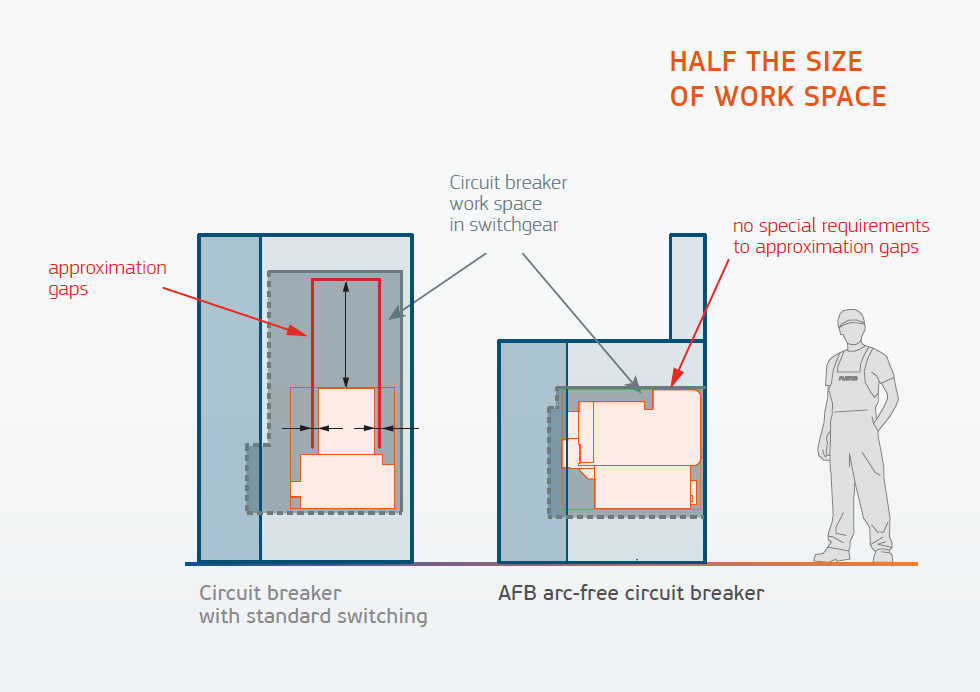
No damaging effect of arc significantly reduces fire risk. No contaminating and toxic combustion products emission, as well no combustion products deposits on circuit breaker components and switchgear units, provide environmental cleanness and safety of circuit breaker operation (see pic. 5).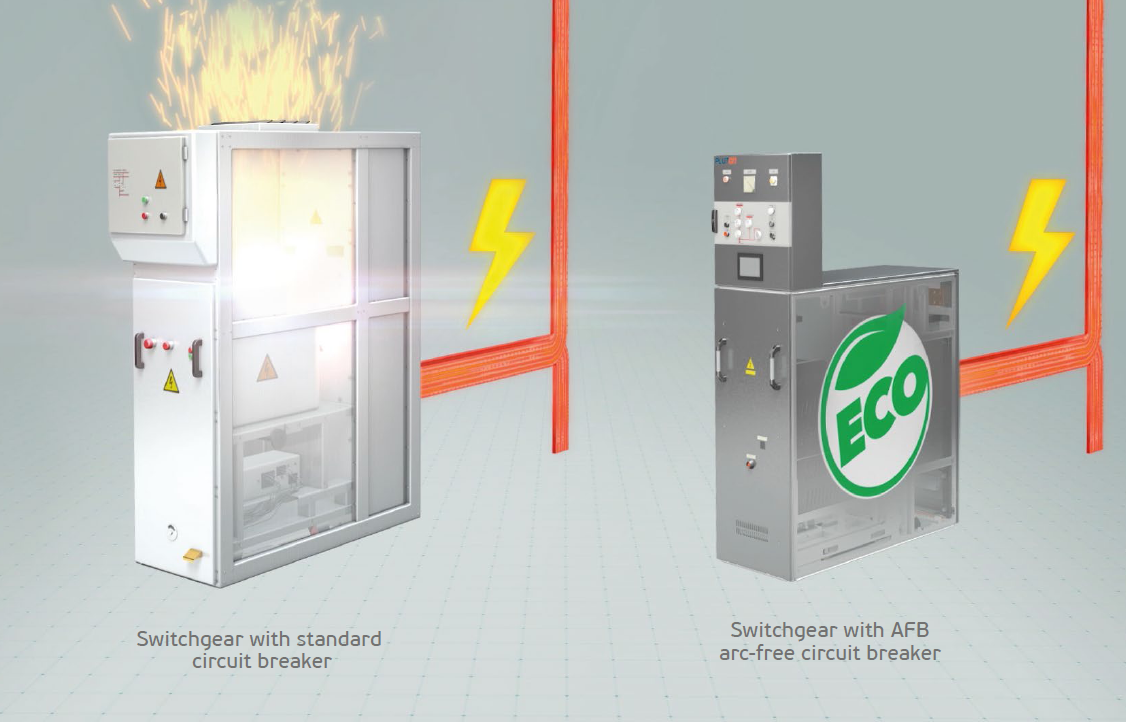
Components and structure of AFB arc-free circuit breaker
Main components and units of circuit breaker:
- vacuum interrupter with high switching resistance;
- high-voltage opening and interrupting capacitors with power source for opening and interrupting system operation;
- electrodynamic tripping drive;
- two–pole disconnector for connection to the switchgear busbars electrical system and for providing visible circuit breaker galvanical interruption. Disconnector does not need any maintenance, and has high dynamic stability and long mechanical life;
- overvoltage protection components;
- microprocessor control and internal monitoring system with fine and flexible parameters setting that provides circuit breaker operation according to the algorithms and continuous monitoring of main units condition;
- line test system;
- interruption and switching thyristors modules with thyristors control components.
Structurally, general view of AFB circuit breakers is shown on the pic. 6.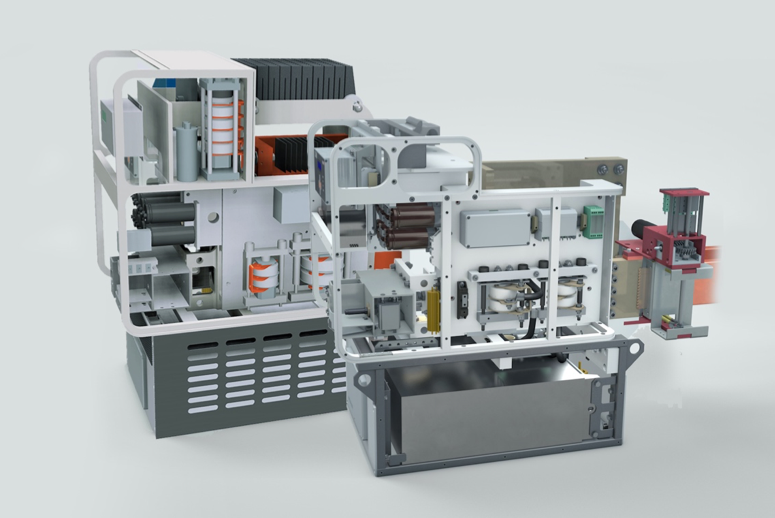
AFB circuit breaker block diagram is shown below (see pic. 7).
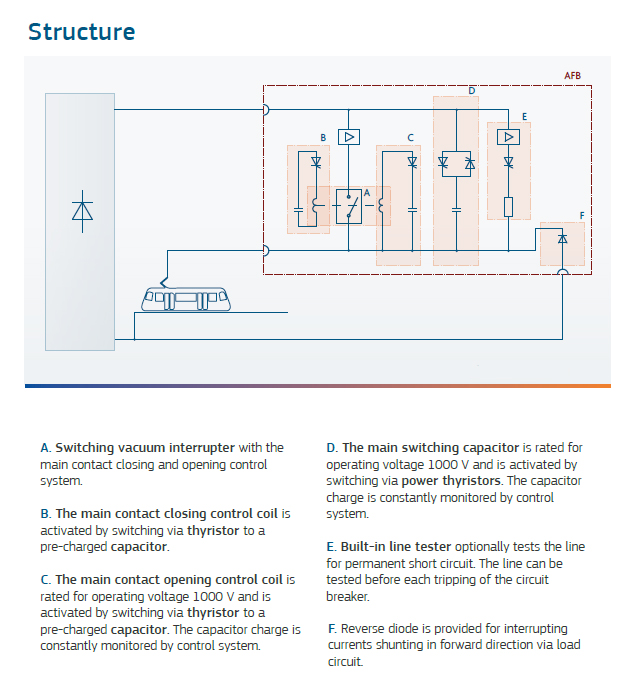
Operation (closing, opening, emergency opening, tripping setting) of AFB arc-free ultra high-speed DC circuit breaker
AFB circuit breaker includes microprocessor control and internal monitoring system that structurally consists of three modules: processor module (pic. 8), measuring module and thyristors control module. This system provides complete all-sufficient control of circuit breaker and its components, and fulfills all necessary functions, including protection (Imax protection and di/dt protection), as well as remote control and measurement functions via isolated RS-485 interface, Modbus RTU protocol.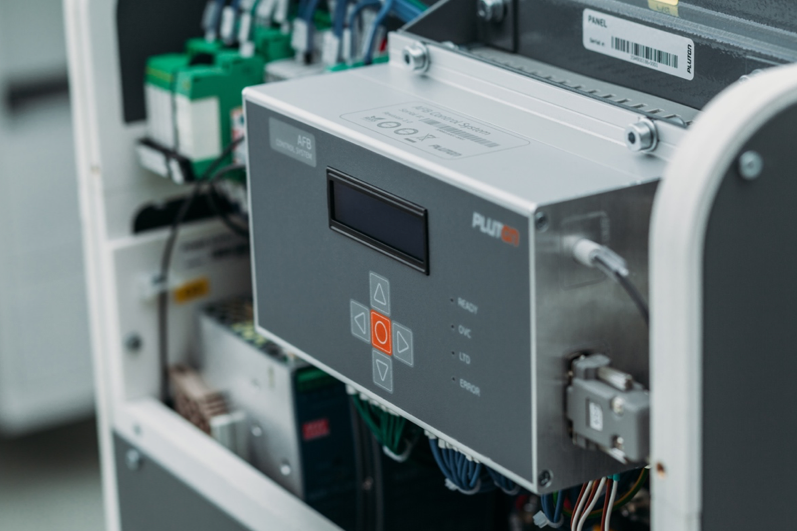
Before circuit breaker tripping control system tests: auxiliaries voltage, high-voltage opening and interrupting capacitors voltage, interrupting thyristors and shunt diodes proper functioning. Closing is possible with preliminary line test and without it.
Closing. Pre-charged low-voltage capacitors battery provides circuit breaker closing by closing coil actuation with closing thyristor.
Operational opening. Circuit breaker control system actuates opening thyristor on receiving opening command. When thyristor opens, the power stored in high-voltage opening capacitor is switched to opening coil. The opening coil magnetic field influences opening mechanism, which actuates vacuum interrupter moving contact, thereby vacuum interrupter power contacts open. Arc starts between vacuum interrupter contacts upon their opening. Pre-charged capacitor with discharge current directed towards load current flow is used for the arc interruption. Capacitor discharge current is switched in antiphase to the main current of power circuit. The arc is interrupted at the moment, when currents algebraic sum is zero. Afterwards the contacts open and interrupt power circuit. (pic. 9).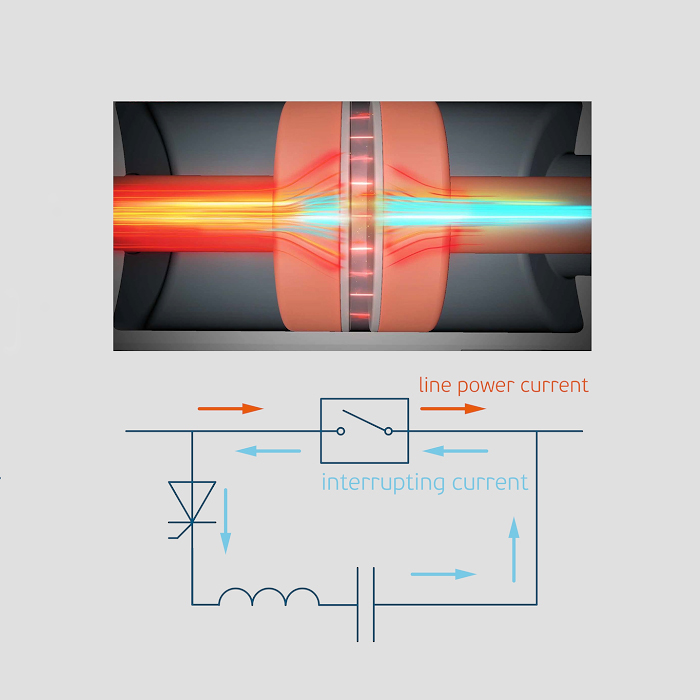
Emergency opening. Emergency opening has similar to operational opening principle. In this case, the signal for opening is measurements from current sensor, installed in the circuit breaker main power circuit, and processed by AFB control system microcontroller according to specified algorithms.
Settings. AFB circuit breaker allows flexible change of the following settings that are confugured in microprocessor control system:
- cut-off current value in positive and negative direction;
- value of current rate of rise (di/dt) in forward and backward direction that allows foreseeing emergency process on the early stage of its occurence;
- short current detectors interruption setting (line test) that controls stay currents of protected equipment and contact network upon offline state of AFB circuit breaker. Prohibition on automatic circuit breaker closing is carried out after exceeding this setting.
AFB circuit breaker is developed and produced according to the international and European standards EN 50123-2/IEC 61992-2, EN 50123-3, IEC 60947-3 requirements.
Main technical characteristics of AFB automatic circuit breaker are listed below:
| Name of parameter | Value | ||
| AFB 25 | AFB 40 | ||
| Voltage | |||
| Rated voltage UNe, V DC | 1000 | ||
| Rated insulation voltage UNm, V DC | 1200 | ||
| Rated limit pulse voltage UNi, V DC | 8000 | ||
|
Maximum switching overvoltage |
2500 | 6000 | |
| Current | |||
| Rated thermal current Ith, Ithe, А DC | 2500 | 4000 | |
| Rated operational current INe, А DC | 2500 | 4000 | |
| Duty class INсw acc. to IEC 60146-1-1 | VI | ||
| Short-circuit current | |||
| Rated short-circuit current INss, kA | 80 | ||
| Rated short-circuit current limit value Iss, kA |
100 | ||
| Interrupting current amplitude Id, kA | <25 | ||
| di/dt limit value, max, kA/ms | 20 | ||
| Time | |||
| Opening time, ms | < 1 | ||
| Total interrupting time, ms | < 4 | ||
| Interrupting current actuation setting range | |||
| Forward current setting range, A | 500 - 7500 | 800 - 12000 | |
| Backward current setting range, A | 500 - 3750 | 800 - 7500 | |
| Weight and size parameters | |||
| Circuit breaker weight, kg | 215 | 280 | |
| Circuit breaker dimensions (mm) Width Height Depth (Length) |
470 810 955 |
470 940 955 |
|
| Additional data | |||
| Vacuum interrupter mechanical/electrical wear resistance | 50 000 | ||
| Protection level | IP 00 | ||
| Auxiliaries supply voltage, V AC/DC | 220, 110, 60 | ||
| Control circuits supply voltage, V DC | 24 | ||
On the basis of AFB arc-free high-speed circuit breaker PLUTON engineers developed created a conceptually new design of DC switchgear (pic. 10), characterized by compact size, maintainability, operational reliability and personnel safety. For the first time this solution PLUTON presented the world's largest rail trade fair InnoTrans 2018 in Berlin.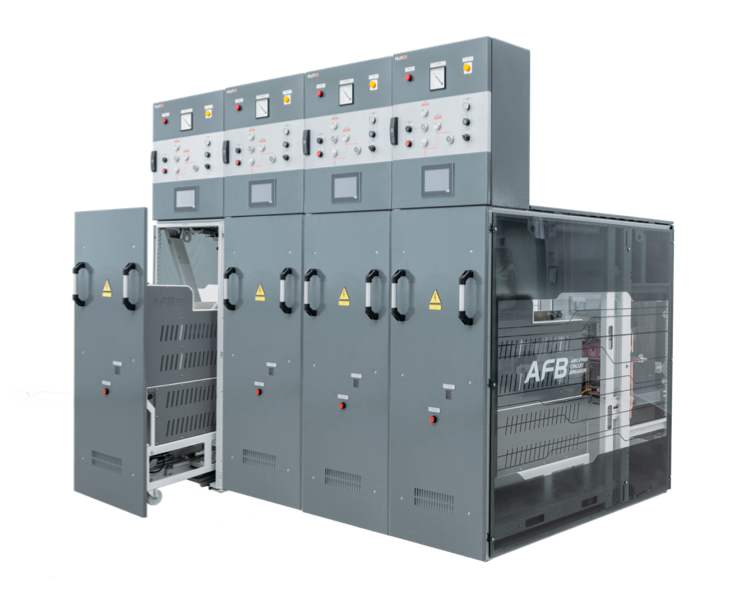
Conclusion
AFB high-speed arc-free circuit breaker is a highly intelligent innovative product that raises a DC switching technology to a much higher level of reliability, long-term operation, economic efficiency and eco-friendliness. Circuit breaker is designed not only for maximum simplification of high-speed circuit breakers operation, but also to protect with high efficiency traction networks, not allowing short circuit currents raising to critical values that can cause damage of contact network and substation equipment and rolling stock, included into traction networks.
We are sure that operating companies will show a keen interest in our innovations for modernization and building of new traction substations for city electric transport, metro and departmental transport of industrial enterprises.

